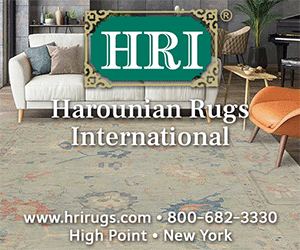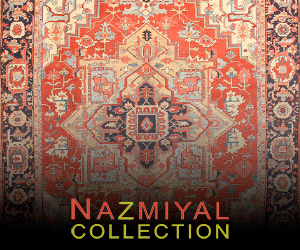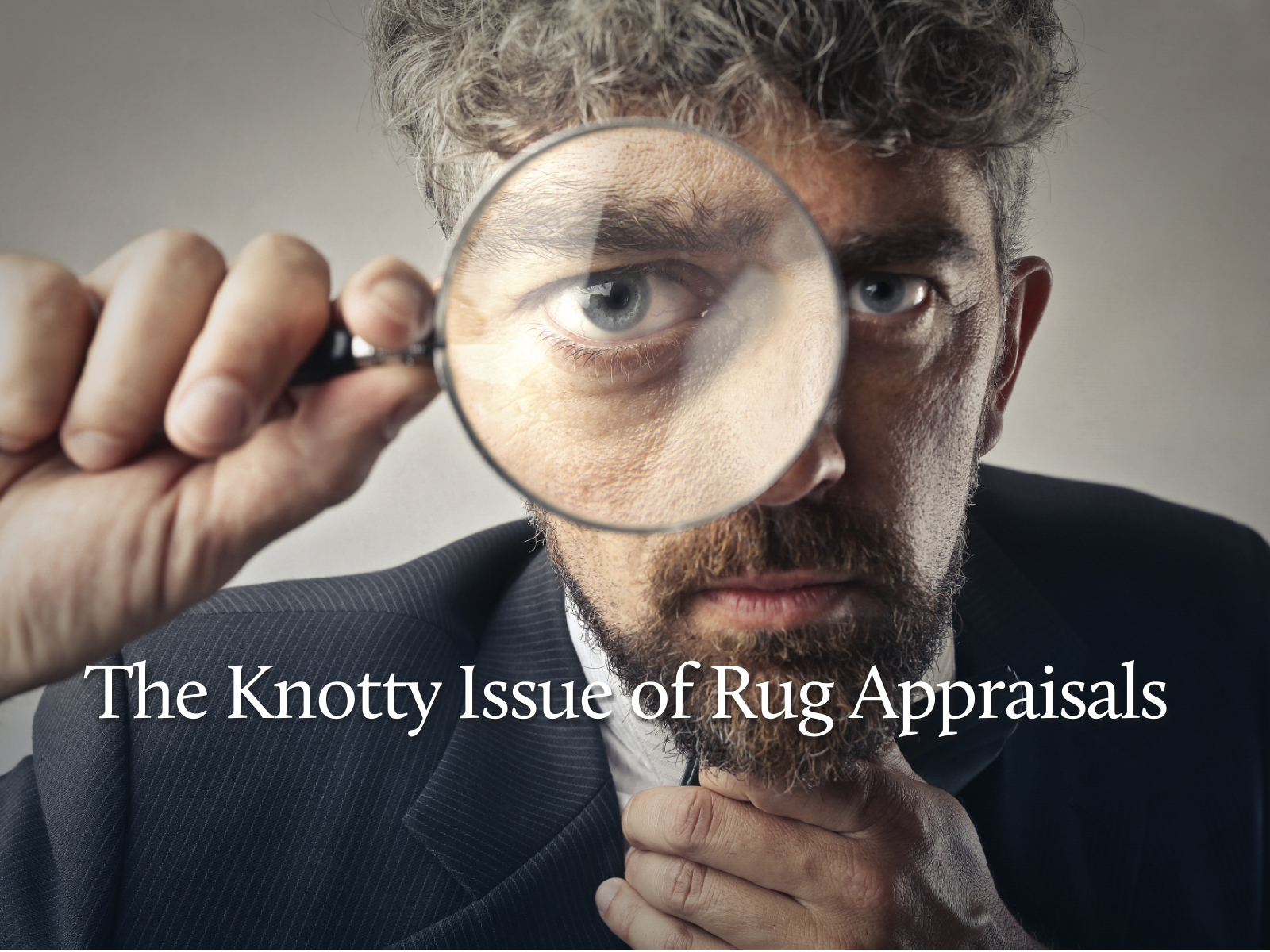Winter is here, and as we welcome 2024, we also say hello to all the “new” in the world of area rugs, as rug vendors are releasing numerous “new rug” designs to kick off the New Year. Flip through the pages of the winter issue of Rug Insider, and you will find hundreds of new rugs from different vendors, with a wide range of colors, styles, and designs. What you are less likely to see, but which is becoming a bigger and bigger part of the area rug industry, are details about the rug appraisal process, along with such related questions as what types of appraisals there are, what purposes they serve, who is asking for them, and what goes into preparing them.
Some of you might have read that first paragraph and thought to yourselves, wait a minute, what the heck is this guy talking about? Aren’t people buying room-sized new rugs online from Amazon and Wayfair, or in-store from HomeGoods and TJ Maxx for $250 or less? If they’re buying the rugs for those prices, why in the world would anybody care about a rug appraisal? These aren’t old cars, where we have to look up the Kelley Blue Book value, they’re rugs! What’s going on here?
It’s true, people are frequently buying new rugs online or from brick-and-mortar vendors, often at impossibly low prices. For many of these buyers, though, the new rugs they are buying are replacements for older rugs that have become stained, damaged, or worn out, or which have been inherited from other family members and are for whatever reason not desired, or which are being sold off when a family is downsizing or redecorating their home.
In all of these scenarios, and many others, there are older, more traditional area rugs that are present in the client’s space, and which the client feels that they can find some value in, either to sell or trade-in, in the process of procuring a newer rug that better fits their taste, their space, their style, their needs, or whatever else.
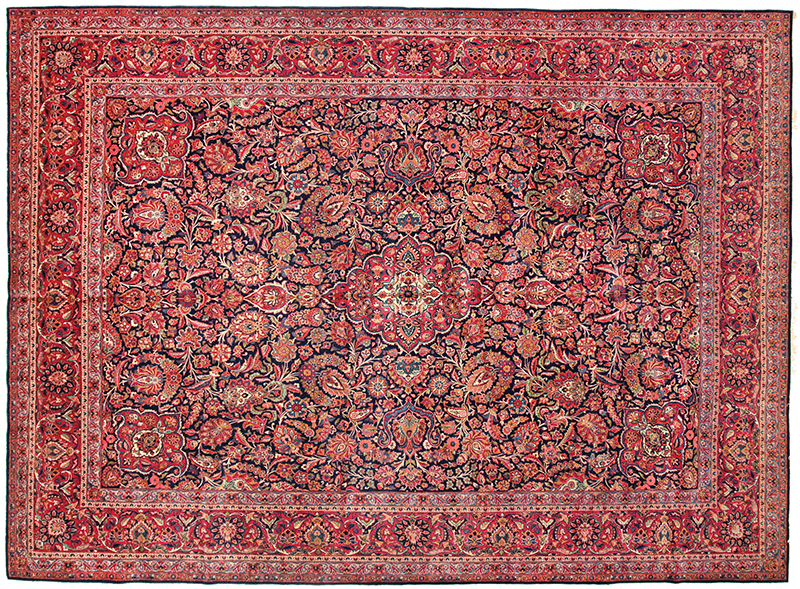
Antique Persian Dabir Kashan, 11’7” x 9’0”, PGNY #29328
What, then, is a rug appraisal, how does the process work, and where do you get one?
A rug appraisal is a process in which a professional with expertise in the field of area rugs will look at a client’s rugs, and based on various criteria, will determine a current value for them. This valuation should be defensible and should be able to stand up to scrutiny.
There are multiple types of rug appraisals and valuations, with each representing a different reason for which the rugs would be appraised, or the manner in which they would be assigned value. We will discuss various types of valuations and appraisals in the breakdown below.
Types of Rug Valuations
Within the realm of rug valuations, two of the most significant types are Retail Replacement Value and Fair Market Value.
Retail Replacement Value: This type of valuation is typically used for insurance purposes, and represents the highest amount that would be needed to replace an existing rug with another rug of similar origin, age, quality, composition, condition, and provenance. These “RRV” valuations are often done within the realm of retail pricing and/or auctions, and may include the cost of taxes, shipping and related fees.
Fair Market Value: This type of valuation is based on the price at which a rug or carpet would go from a buyer to a seller, with less time pressure than in an RRV valuation, and with both parties having a reasonable amount of knowledge of the relevant information about the rugs. The IRS often uses the “FMV” for appraisals.
Who are the parties who are performing rug appraisals, and how do they differ?
Rug Appraisal Providers
There are many people in the industry who routinely provide rug appraisals and valuations for their clientele. Let’s examine some of the main categories.
Rug Dealers: Rug dealers trade in rugs for a living, and know the relative values of different styles of rugs from different sources. Rug dealers who also offer cleaning and restoration services are particularly knowledgeable about current rug values, as they regularly are in contact with clients who need to have their rugs cleaned and repaired, and in that process, are often informed of where the clients purchased their rugs, and how much they purchased them for. During the cleaning and repair process, rug dealers are also frequently asked how much the rug in question would trade for in today’s market, so a good rug dealer should be aware of current market forces, and how much different rugs are worth.
For myself at Persian Gallery New York, this is something we experience very frequently, where people send us their rugs for cleaning and restoration, and either in tandem or independent of that, they ask us to provide them a valuation.
Note: You can email This email address is being protected from spambots. You need JavaScript enabled to view it. if we can be of assistance with your rug appraisal and valuation needs.
In some cases, rug dealers will refrain from providing appraisals and valuations for their clients. Why, you might ask? Because in some cases, these appraisals and valuations can cause a conflict of interest, or can be detrimental to the vendor’s relationship with the client!
For instance, if an existing client (or even a potential client) asks a rug dealer to provide a valuation on a rug that they purchased at the height of the market for $50,000, and in today’s market, that rug would be valued at a significantly lower price, it might not behoove the rug dealer to provide the valuation for the client. Similarly, if the client purchased their rug in a geographic location that carries higher prices than other locations (ie., they bought it in New York City for $25,000, but in Oklahoma, it would be valued at a much lower price), then that is also a possible conflict. In another example, if a client bought the rug at retail, and is trying to sell it to someone at the wholesale end of the market, that might also be problematic, in that those are different ends of the pricing continuum, and the valuations might not be in sync.
Another consideration in this same area is impartiality, as a client might suspect that a rug dealer is giving them a valuation that is either too high or too low, so as to better position the rug in question to sell at a questionable price, or to be replaced with something of higher or lower value.
In cases like these, and in many others, rug dealers might pass on performing the rug appraisal or valuation for the client, and suggest to the client that they seek out the services of a Professional Appraiser.
Professional Appraisers: There are a select few people in the industry who are not rug vendors, themselves, but who have an extremely high level of expertise in rugs, collectibles, and antiques, and who work diligently to stay on top of the current values of different types of area rugs. These professional appraisers comply with USPAP, or the Uniform Standards of Professional Appraisal Practice, and who are skilled in writing professional appraisal reports.
One of the people who best fits this description, and who is a true expert in rug appraisals and valuations, is Steve Boodakian of The MERA Group. Steve spent decades in the rug industry as a rug vendor, and then shifted into the realm providing consultations, appraisals, and valuations. His is one of the most respected names in the industry, and he is a fountain of information about rugs, the past and present of the rug trade, and the ins and outs of the appraisal and valuation process.
Note: You can email Steve Boodakian with your rug appraisal and valuation needs at This email address is being protected from spambots. You need JavaScript enabled to view it..
Since Steve Boodakian, and others who fit in this category of expert rug appraisers, do not actively sell rugs, they have less likelihood of running into some of the conflicts of interest enumerated above, and can give impartial, objective appraisals, which are neither slanted toward the rug vendors nor toward the clients.
A sample appraisal from Steve Boodakian and The MERA Group is shown at the end of this article for reference.
Who are the people who seek out rug appraisals from rug dealers or from professional appraisers? There are a wide range of people seeking those services, including insurance companies, public adjusters, attorneys, tax professionals, and private clients.
Who Obtains Rug Appraisals
Insurance Companies: Insurance companies are regularly called upon to seek appraisals and valuations of people’s belongings, including area rugs and other valuables, either in the process of people setting up an insurance plan that would be comprehensive enough to cover a realistic dollar amount for their valuables, or in other cases, to reimburse people for the losses of said valuables, in the case of fire, flooding, theft, or damage. They typically provide the Retail Replacement Value.
Public Adjusters: Public adjusters will frequently work with people who are submitting claims to insurance companies after suffering a loss, with the same ideas of establishing a Retail Replacement Value, in the cases of determining a level of reimbursement after a major loss due to acts of nature, catastrophic fire, structural issues causing damage to people’s belongings, or a host of other issues.
Attorneys: Attorneys will often obtain rug appraisals, either for estate planning purposes, for settling issues related to wills, divorces, bankruptcies, or other issues, or even to settle disputes between parties over who owes whom what, and what values to assign to some of the items in question.
Tax Professionals: Tax professionals will seek out rug values for the clients, either in terms of preparing a client’s annual tax return, or in terms of their tax liabilities and other issues. Depending on whether the client is an individual, a company, or some other type of entity, tax professionals will determine whether inherited or gifted rugs are subject to taxes, whether items being sold or donated are taxable, etc.
Private Clients: Private clients will often seek out appraisals or valuations of their rugs, either because they inherited them and no longer want them, because they are downsizing and disposing of larger rugs, because they are redecorating and no longer want or need the rugs, because the rugs are worn out or excessively stained, because their rugs are damaged or destroyed and the client is seeking reimbursement from insurance, and a host of other scenarios.
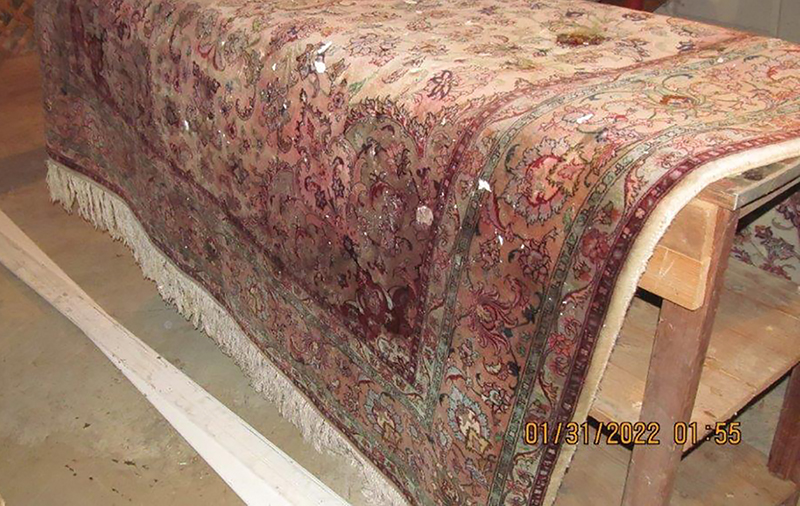
A water-damaged rug that was sent to PGNY for a valuation.
When these different types of clients approach a rug dealer or a professional appraiser to provide a rug appraisal or valuation, what sources to those experts consult to make sure that they are providing an accurate price?
Rug Valuation Price Sources and Comparatives
When an insurance company, a public adjuster, an attorney, a tax professional, or a private client seeks out a rug valuation from a rug dealer or a professional appraiser, there are various sources that those experts can draw upon in putting together their rug valuation, depending on what type of valuation is being requested.
If the person providing the valuation is a rug dealer, and they routinely trade in rugs, either at the retail or wholesale price level, then the Fair Market Value for the client’s rug should be well within the realm of their personal and/or professional knowledge.
If, for some reason, the rug dealer is a retailer and is unsure of wholesale prices, or vice versa, then they can consult with colleagues in the respective end of the industry they have less expertise in and collect information that way.
Similarly, with the proliferation of online rug marketplaces and online rug auctions, there are numerous sources easily accessible online which one can go to get a sense of what comparable rugs are currently being sold for, such as 1stdibs.com, a luxury online marketplace, along with the online auction websites of Nazmiyal Auctions, Material Culture, Sotheby’s, Christie’s, Bonham’s, Doyle, and many others.

Antique 17th Century Brussels Mythological Tapestry, 12’ x 13’, PGNY #24800 listed on 1stdibs.com
While the rugs being sold on these online forums sometimes represent different parts of the spectrum of rug pricing, with sites like 1stdibs representing a higher end of the price spectrum, and the different auction sites ranging from high to low on the price spectrum, they provide a frame of reference for the people preparing the appraisals, and can serve as a comparable from which the valuation can be oriented.
With a comparable and with other details about age, condition, provenance, and more in hand, a rug expert can prepare a professional rug valuation report for their client, which should ideally include clear and high-resolution images of the rugs in question, along with a written description of the rug, a condition report, information about the rug’s origin, composition, and more.
Even then, while a picture may be worth a thousand words, a well-produced, thoroughly researched rug valuation can be worth much more than that, with thousands of dollars in value, and with a happy client to strengthen a relationship with moving forward into the future.
And in the area rug industry, we should all remember that nothing is more valuable than a happy client!
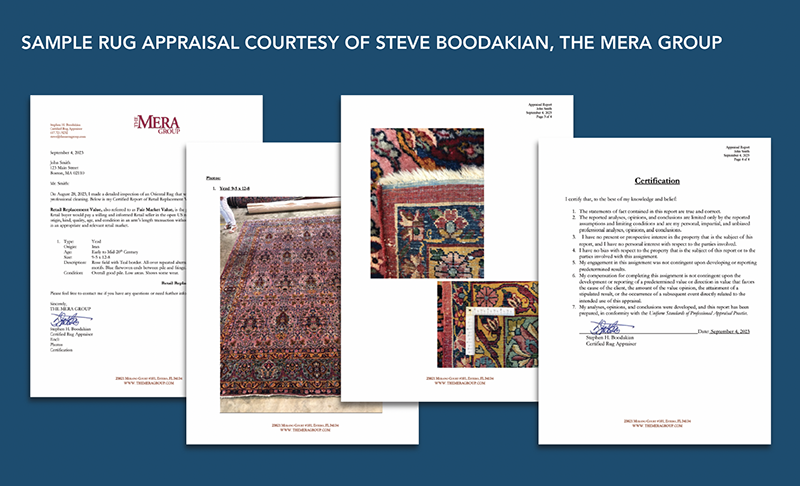
Sample appraisal by Steve Boodakian, The Mera Group


